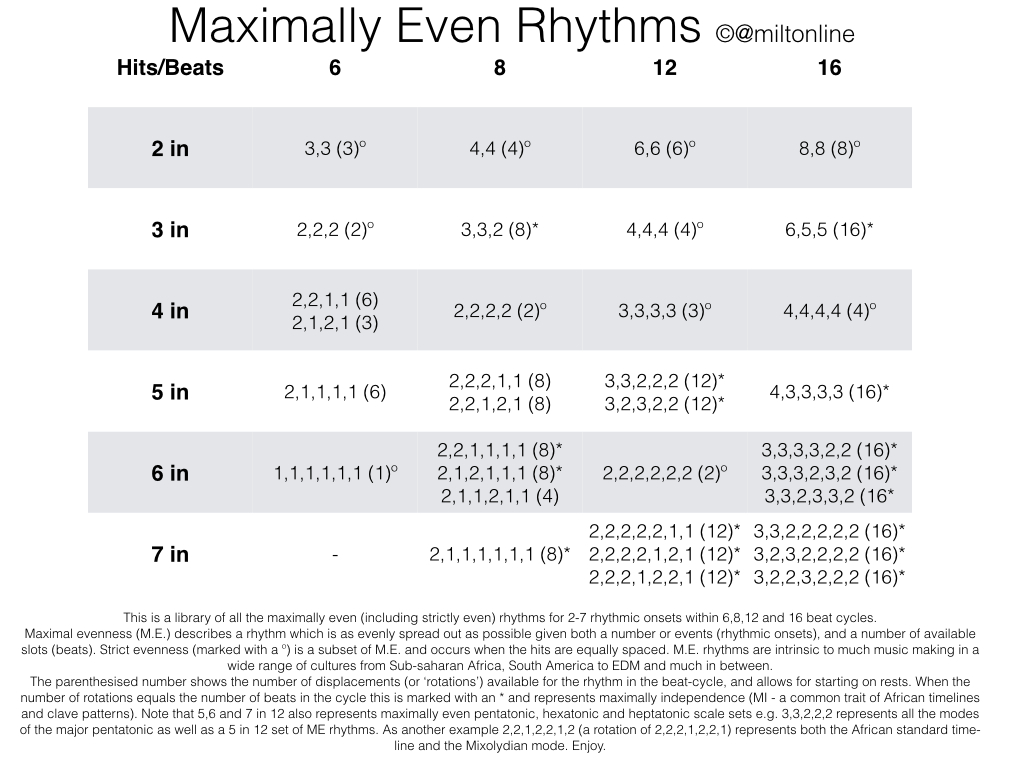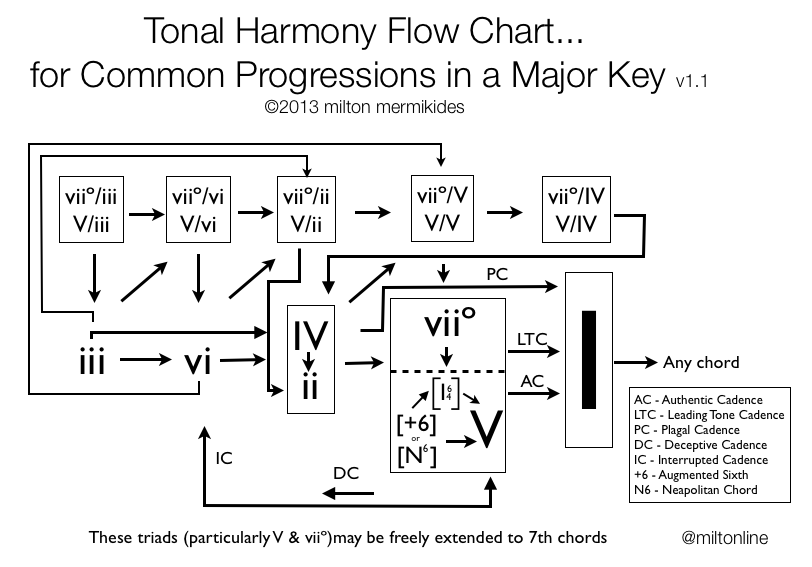Tag: music
Maximally Even Library
UPDATE- Since the publication of Brad Osborn’s Kid Algebra (2014), I’m going to switch to his category of Euclidean rhythms (in their 4 types) to describe the patterns below. In summary, Euclidean rhythms (ER) are rhythms in which k onsets in n divisions are as similar as possible, which essentially means that they will only differ by at most one subdivision each. So in ER the groups are as similar as possible, but the term maximally even we will reserve for ER rhythms where the smaller note groups are as separated as much as possible. For example, (2,2,3,3) and (2,3,2,3) are both ER, but only the latter is maximally even.
This is a library of all the maximally even (including strictly even) rhythms for 2-7 rhythmic onsets within 6,8,12 and 16 beat cycles.
Maximal evenness (M.E.) describes a rhythm which is as evenly spread out as possible given both a number or events (rhythmic onsets), and a number of available slots (beats). Strict evenness (marked with a º) is a subset of M.E. and occurs when the hits are equally spaced. M.E. rhythms are intrinsic to much music making in a wide range of cultures from Sub-saharan Africa, South America to EDM and much in between.
The parenthesised number shows the number of displacements (or ‘rotations’) available for the rhythm in the beat-cycle, and allows for starting on rests. When the number of rotations equals the number of beats in the cycle this is marked with an * and represents maximally independence (MI – a common trait of African timelines and clave patterns). Note that 5,6 and 7 in 12 also represents maximally even pentatonic, hexatonic and heptatonic scale sets e.g. 3,3,2,2,2 represents all the modes of the major pentatonic as well as a 5 in 12 set of ME rhythms. As another example 2,2,1,2,2,1,2 (a rotation of 2,2,2,1,2,2,1) represents both the African standard time-line and the Mixolydian mode. Enjoy.
I have been thinking about ‘nutshell’ images for a range of musical concepts. Here’s a work in progress on common progressions in a major key in 17-19th century tonal harmony. Yes caveat, WIP etc, but it seems quite useful. Comments and suggestions welcome! Minor key next, please don’t let me turn them into 3D models for mode mixtures and modulations.
Here’s a short educational video explaining some fundamental concepts of maths and tuning. Nice production by frequent collaborator Anna Tanczos of Sci-Comm Studios.
Welcome To The Real World
Just returned from 4 days at Peter Gabriel’s Real World Studios.
Wow, what a place! High-end technology and a Pavlovian saliva-inducing stash of microphones & gear.
All that would you expect from a good studio, what makes Real World a uniquely wonderful residential studio is the great effort made to make the artists feel relaxed with wonderful surroundings. The studios are perfectly sound proofed yet awash with natural light. Cast your gaze up from the mixing desk and you are treated with a delightful view of a bridge over a stream amidst gorgeous English countryside. Stroll through the picturesque Wilstshire grounds, coffee in hand between takes. Or why not, mid-recording, gaze at a running stream through the glass floor of the studio. A team of helpful people or on hand to keep you in excellent home-cooked food & endless hot beverage. The ideal place to work.
So what did the precocious Peter Gregson and I achieved in those 4 short days? A superb recording of Steve Reich’s 2003 work ‘Cello Counterpoint’ for 8 cellos. What a pieces: labyrinthine rhythmic ideas, stunning ensemble interplay & a deep jzz-influenced harmonic language. Our production really is something special. But we earned it, 4 looong days of intense work, We go back to mix in the next few weeks, (together with some original compositions) and look forward to sharing the album with the world.
Now for some unedited sleep.

